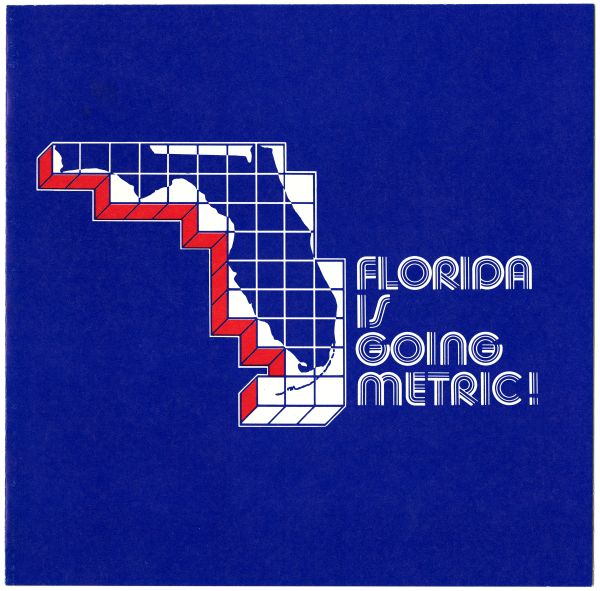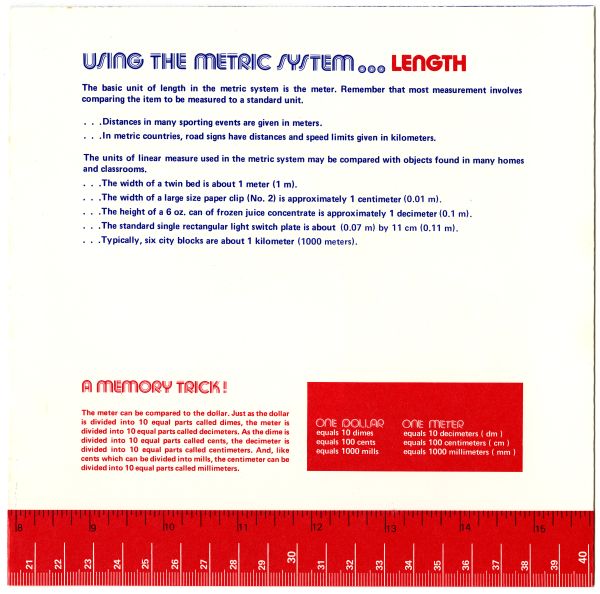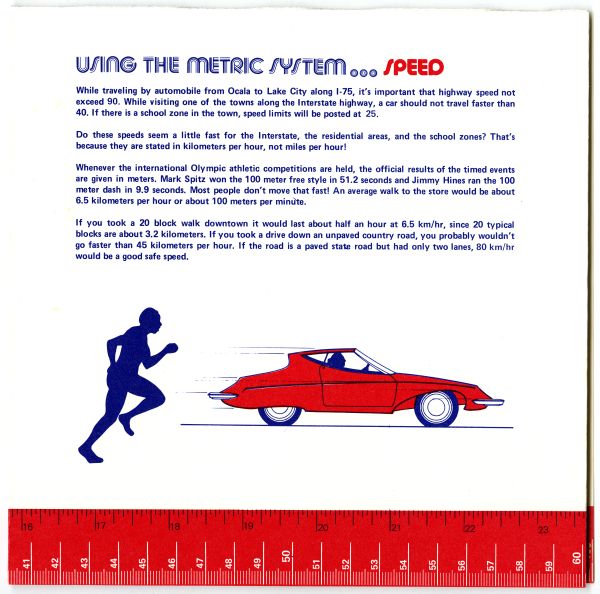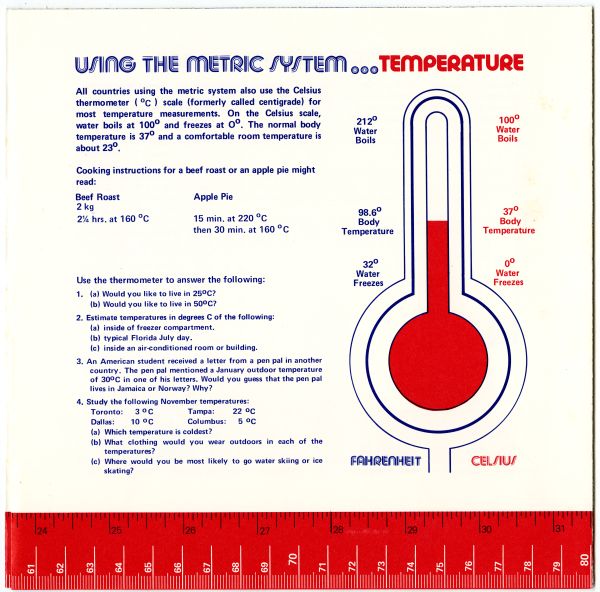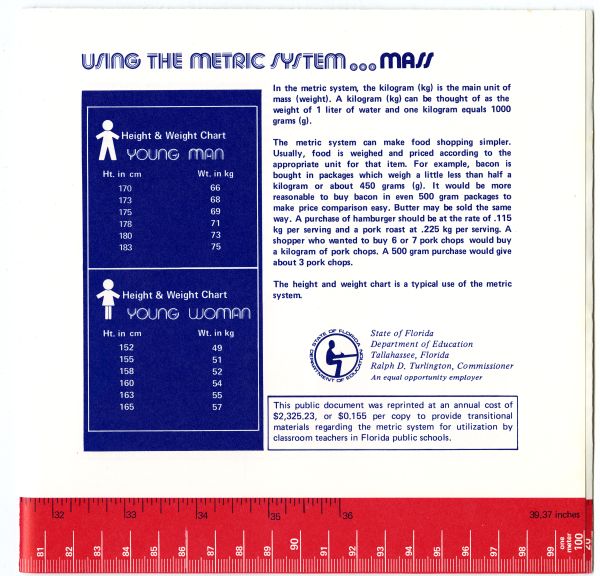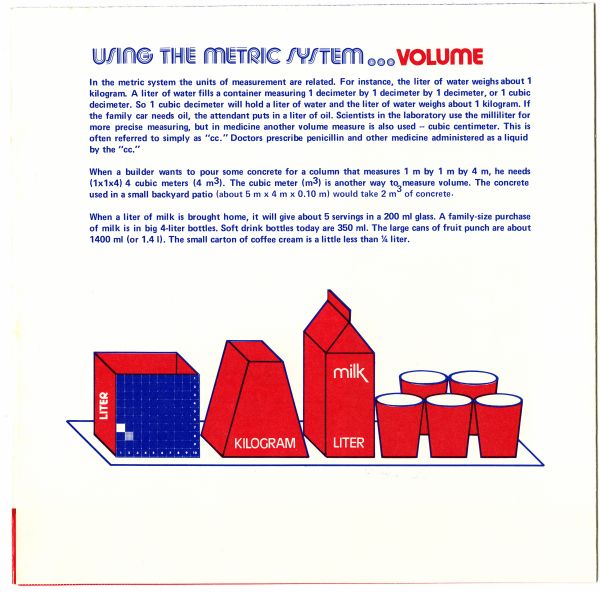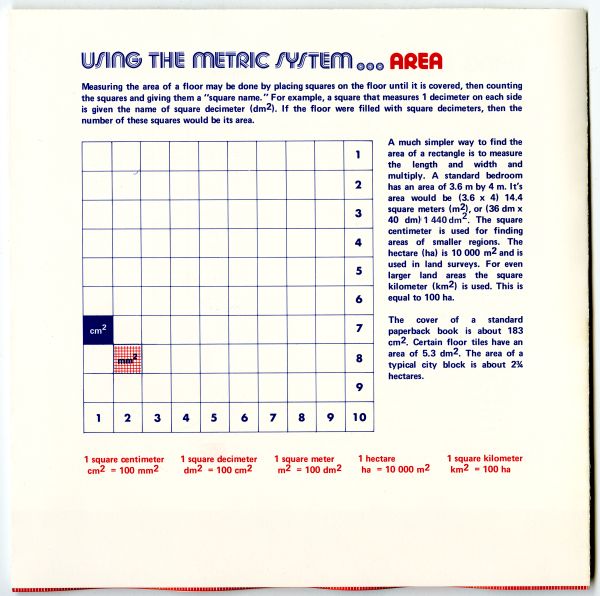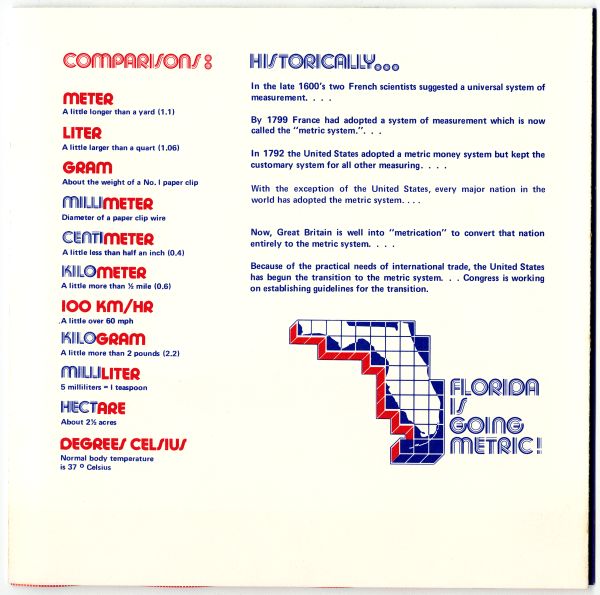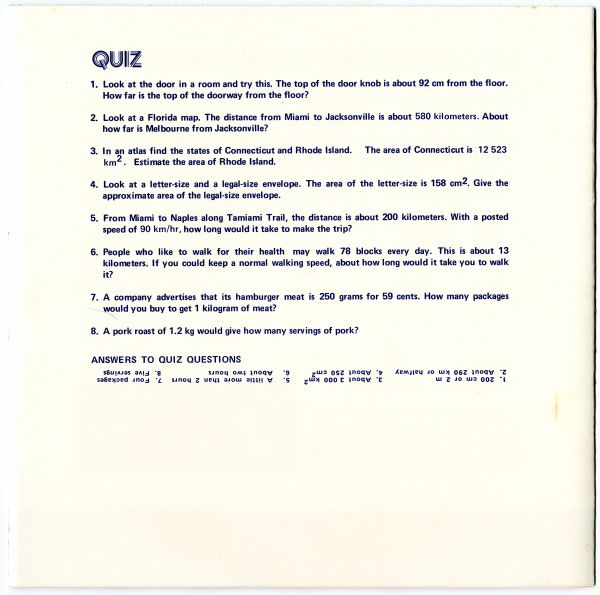Florida Memory is administered by the Florida Department of State, Division of Library and Information Services, Bureau of Archives and Records Management. The digitized records on Florida Memory come from the collections of the State Archives of Florida and the special collections of the State Library of Florida.

State Archives of Florida
- ArchivesFlorida.com
- State Archives Online Catalog
- ArchivesFlorida.com
- ArchivesFlorida.com
State Library of Florida
Related Sites
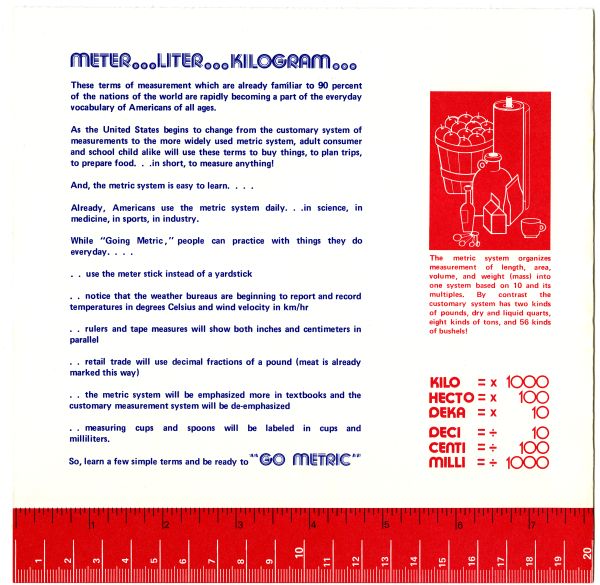
Description of previous item
Description of next item

Source
Description
Date
Creator
Format
Topic
Subjects
Geographic Term
METER... LITER... KILOGRAM...
These terms of meaurement which are already familiar to 90 percent of the nations of the world are rapidly becoming a part of the everyday vocabulary of Americans of all ages.
As the United States begins to change from the customary system of measurements ot more widely used metric system, adult consumer and school child alike will use these terms to buy things, to plan trips, to prepare food... in short, to measure anything!
And, the metric system is easy to learn....
Already, Americans use the metric system daily... in science, in medicine, in sports, in industry.
While "Going Metric," people can practice with things they do everyday....
.... use the meter stick instead of a yardstick
.... notice that the weather bureaus are beginning to report and record temperatures in degrees Celsius and wind velocity in km/hr
... rulers and tape measures will show both inches and centimenters in parallel
... retail traid will use decimal fractions of a pound (meat is already marked this way)
... the metric system will be emphasized more in textbooks and the customary measurement system will be de-emphasized
.... measuring cups and spoons will be labeled in cups and milliliters.
So, learn a few simple terms and be ready to "GO METRIC"
The metric system organizes measurement of length, area, volume, and weight (mass) into one system based on 10 and its multiples. By contrast the customary system has two kinds of pounds, dry and liquird quarts, eight kind of tons, and 56 kinds of bushels!
KILO = X1000
HECTO = X100
DEKA = X10
DECI = DIVIDED 10
CENTI = DIVIDED 100
MILLI = DIVIDED 1000
Title
Subject
Description
Creator
Source
Date
Format
Language
Type
Identifier
Coverage
Geographic Term
Thumbnail
Display Date
ImageID
topic
Subject - Corporate
Subject - Person
Transcript
METER... LITER... KILOGRAM...
These terms of meaurement which are already familiar to 90 percent of the nations of the world are rapidly becoming a part of the everyday vocabulary of Americans of all ages.
As the United States begins to change from the customary system of measurements ot more widely used metric system, adult consumer and school child alike will use these terms to buy things, to plan trips, to prepare food... in short, to measure anything!
And, the metric system is easy to learn....
Already, Americans use the metric system daily... in science, in medicine, in sports, in industry.
While "Going Metric," people can practice with things they do everyday....
.... use the meter stick instead of a yardstick
.... notice that the weather bureaus are beginning to report and record temperatures in degrees Celsius and wind velocity in km/hr
... rulers and tape measures will show both inches and centimenters in parallel
... retail traid will use decimal fractions of a pound (meat is already marked this way)
... the metric system will be emphasized more in textbooks and the customary measurement system will be de-emphasized
.... measuring cups and spoons will be labeled in cups and milliliters.
So, learn a few simple terms and be ready to "GO METRIC"
The metric system organizes measurement of length, area, volume, and weight (mass) into one system based on 10 and its multiples. By contrast the customary system has two kinds of pounds, dry and liquird quarts, eight kind of tons, and 56 kinds of bushels!
KILO = X1000
HECTO = X100
DEKA = X10
DECI = DIVIDED 10
CENTI = DIVIDED 100
MILLI = DIVIDED 1000
USING THE METRIC SYSTEM... LENGTH
The basic unit of length in the metric system is the meter. Remember that the most measurement involves comparing the item to be measured to a standard unit.
... Distances in many sporting events are given in meters.
... In metric countries, road signs have distances and speed limits given in kilometers.
The unites of linear measure used in the metric system may be compared with objects found in many homes and classrooms.
... The width of a twin bed is about 1 meter (1m).
... The width of a large size paper clip (No. 2) is approximately 1 centimeter (0.01m).
... The height of a 6 ox. can of frozen juice concentrate is approximately 1 decimenter (0.1 m).
... The standard single rectangle light switch plate is about (0.07 m) by 11 cm (0.11m).
... Typically, six city blocks are about 1 kilometer (1000 meters).
A MEMORY TRICK!
The meter can be compared to the dollar. Just as the dollar is divided into 10 equal parts called dimes, the meter is divided into 10 equal parts called decimeters. As the dime is divided into 10 equal parts called cents, the decimeter is divided into 10 equal parts called centimeters. And, like cents which can be divided into mills, the centimeter can be divided into 10 equal parts called millimeters.
One Dollar
equals 10 dimes
equals 100 cents
equals 100 mills
One meter
equals 10 decimeters (dm)
equals 100 centimeters (cm)
equals 1000 millimeters (mm)
USING THE METRIC SYSTEM... SPEED
While traveling by automobile from Ocala to Lake City along I-75, it's important that highway speed not exceed 90. While visiting one of the towns along the Interstate highway, a car should not travel faster than 40. If there is a school zone in the town, speed limits will be posted at 25.
Do these speeds seem a littel fast for the Interstate, the residential areas, and the school zones? That's because they are stated in kilometers per hour, not miles per hour!
Whenever the international Olympic athletic competitions are held, the official results of the timed events are given in meters. Mark Spitz won the 100 meter free style in 51.2 seconds and Jimmy Hines ran the 100 meter dash in 9.9 secons. Most people don't move that fast! An average walk to the store would be about 6.5 kilometers per hour or about 100 meters per minute.
If you took a 20 block walk downtown it would last about half an hour at 6.5 km/hr, since 20 typical blocks are about 3.2 kilometers. If you took a drive down an unpaved country road, you probably wouldn't go faster than 45 kilometers per hour. If the road is a paved state road but had only two lanes, 80 km/hr would be a good safe speed.
USING THE METRIC SYSTEM... TEMPERATURE
All countires using the metric system also uses the Celsius thermometer (degrees Celsius) scale (formerly called centirgrade) for most temperature measurements. On the Celsius scale, water boils at 100 degrees, and freezes at 0 degrees. The normal body temperature is 37 degrees and a comfortable room temeprature is about 23 degrees.
Cooking instruction for a beef roast or an apple might read:
Beef Roast
2kg
21.4 hrs at 160 degrees Celsius
Apple Pie
15 min at 22 degrees Celsius
then 30 min at 160 degrees Celsius
Use the thermometer to answer the following:
1. (a) Would you like to live in 25 degrees Celsius?
(b). Would you like to live in 50 degrees Celsius?
2. Estimate temperatures in degrees C of the following:
(a) inside of freezer compartment
(b) typical Florida July day.
(c) Inside an air-conditioned room or building.
3. An American student received a letter from a pen pal in another country. The pen pal mentioned a January outdoor temperatre of 30 degrees Celsius in one of his letters. Would you guess that the pen pal lives in Jamaica or Norway? Why?
4. Study the following November temperatures:
Toronto: 3 degrees Celsius
Tampa: 22 degrees Celsius
Dallas: 10 degrees Celsius
columbus: 5 degrees Celsius
(a) Which temperature is coldest?
(b) What clothign would you wear outdoors in each of the temperatures?
(c) Where would you be most likely to go water skiing or ice skating?
212 degrees Water Boils
98.6 degrees Body Temperature
32 degrees Water Freezes
FAHRENHEIT
100 degrees Water Boils
37 degrees Body Temperature
0 degrees Water Freezes
Celsius
USING THE METRIC SYSTEM... MASS
In the metric system, the kilogram (kg) is the main unit of mass (weight). A kilogram (kg) can be thought of as the weight of 1 liter of water and one kilogram equals 1000 grams (g).
The metric system can make food shopping simpler. Usually, food is weighed and priced according to the appropriate unit for that item. For example, bacon is bought in packages which eight a little less than half a kilogram or about 450 grams (g). It would be more reasonable to buy bacom in even 500 gram packages to make price comparison easy. Butter may be sold the same way. A purchase of hamburger should be at the rate of .115 kg. per serving and a pork roast at ...25 kg. per serving. A shopper who wanted to buy 6 or 7 pork chops would buy a kilogram of pork chops. A 500 gram purchas would give about 3 pork chops.
The height and weight chart is a typical use of the metric system.
State of Florida Department of Education
Tallahassee, Florida
Ralph D. Turlington, Commissioner
An equal opportunity employer.
This public documnt was reprinted at an annual cost of $2,325.23 or $0.155 per copy to provide transitional materials regarding the metric system for utilization by classroom teachers in Florida public schools.
Chicago Manual of Style
Florida Department of Education. Florida is Going Metric! - brochure, ca. 1980. 1980 (circa). State Archives of Florida, Florida Memory. <https://www.floridamemory.com/items/show/298144>, accessed 18 December 2025.
MLA
Florida Department of Education. Florida is Going Metric! - brochure, ca. 1980. 1980 (circa). State Archives of Florida, Florida Memory. Accessed 18 Dec. 2025.<https://www.floridamemory.com/items/show/298144>
AP Style Photo Citation
(State Archives of Florida/Florida Department of Education)

 Listen: The Bluegrass & Old-Time Program
Listen: The Bluegrass & Old-Time Program